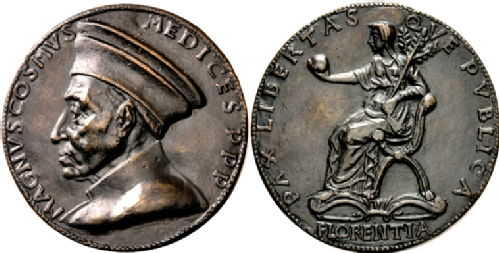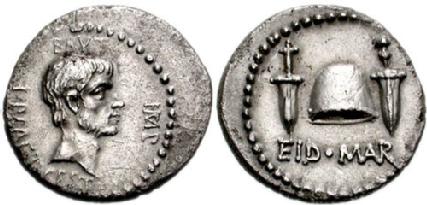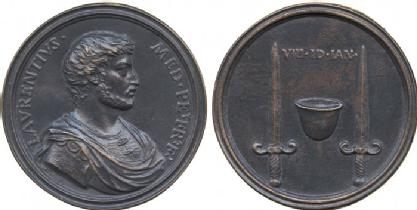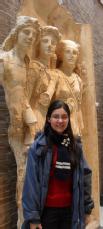All 2 entries tagged Renaissance
View all 4 entries tagged Renaissance on Warwick Blogs | View entries tagged Renaissance at Technorati | There are no images tagged Renaissance on this blog
January 01, 2014
Medal of Cosimo de' Medici, Pater Patriae
 |
| Medallion of Cosimo I de'Medici as Pater Patriae |
This bronze medal is the earliest example of a product created by the Florentine school. It celebrates Cosimo I de’Medici (1389-1464). He was the head of the de’Medici family, a family of bankers who were the de facto rulers of Florence during most of the Italian Renaissance. Cosimo I was granted the title Pater Patriae by the Florentine Signoria after his death on 1 August 1464. According to some scholars, the title was actually conferred on him through a decree dated to 20th August 1464, while others argue that he was granted this title through a decree dated to March 16th 1465. However, the medal was certainly not produced after 1469, the year of Piero il Gottoso’s death; the latter was the dedicatee of an Aristotelian manuscript —Florence, Biblioteca Medicea Laurenziana, Ms Plut. 84, I, c. 3— which was produced by Francesco di Antonio del Chierico on behalf of Piero di Lorenzo de’Medici. Indeed, the effigy of the medal was copied in an illumination of the manuscript by Francesco del Chierico.
The obverse of the medal presents the bust of Cosimo I in profile, facing left. He is wearing a flat beret, which was proper for persons of high rank, and a buttoned cloak. The circular legend, in Roman capital letters, reads as follows: MAGNVS COSMVS MEDICES P(RIMVS) P(ATER) P(ATRIAE).
The reverse shows a female figure, seated on a throne, which is the allegory of Florence: indeed the exergue reads FLORENTIA. The figure is inspired by Graeco-Roman coins depicting Concordia. She is wearing a peplos and is veiled, likely as a sign of mourning for Cosimo. In her left hand she holds an olive branch ending in three shoots. In the other hand, stretching forward, she grasps a globe, which might recall the Medici family emblem: a set of red balls on a gold shield. The folding seat of Florentia is placed upon a yoke on the ground. The circular legend of the reverse reads PAX LIBERTASQVE PVBLICA.
A golden exemplar of the medal is shown in a relief in gilded stucco inset into the Portrait of a Young Man with a Medal of Cosimo il Vecchio by Botticelli, now preserved in the Uffizi. The likeness of Cosimo de’ Medici depicted in the medal also inspired numerous posthumous portraits of him, including that by Jacopo Pontormo in the Uffizi.
Many different artists have been proposed for the medal’s creator: Niccolò di Forzore Spinelli, Donatello, Michelozzo, Cristoforo di Geremia, and Bertoldo di Giovanni. Nevertheless, the controversial question concerning the author’s identification basically remains a mystery. According to a fascinating interpretation, the young man depicted in the portrait by Botticelli might be the designer of the medal, Antonio Botticelli, the painter’s brother. Antonio Botticelli had indeed recast and gilded medals, working in the court of the Medici family.
The whole idea of a ʽportraitʼ on coins, as shown here, as well as the title pater patriae, was inspired by the rediscovery of Roman coins in the Renaissance, as medieval coinage did not have portraits. Ancient coins, especially the Roman imperial sestertii, were the subject of interest and intense study among Renaissance scholars from the early fifteenth century onwards. These coins were admired by humanists for their large size, their high relief, and the use of bronze, which was rarely used for medieval coinage. As a result of a process that started in the thirteenth century, various minting authorities introduced significant innovations in the appearance of the circulating coinage. Additionally, the influence of some aspects of ancient coinage resulted in the creation of a new artistic medium in the medal.
A substantial difference between Roman imperial coins and their medieval counterparts was, first of all, the profile portrait bust of a ruler on the obverse, and secondly the representation of classical deities, contemporary scenes or monuments on the reverse. Coins of the later Middle Ages did not have the reverse exergue line, often with letters beneath it, and the legends were less detailed and written in the Gothic letters derived from medieval book hands rather than the Roman capital letters used on imperial coins.
 This month’s coin was chosen by Rocco Di Dio, a third-year PhD student. His research project focusses on three Greek manuscripts produced by the Renaissance scholar Marsilio Ficino (1433-1499), who was largely responsible for the revival of Platonism in western Europe. Rocco’s main interests lie in Palaeography, Codicology, Byzantine Studies, Platonic philosophy and the Renaissance reception of Platonism.
This month’s coin was chosen by Rocco Di Dio, a third-year PhD student. His research project focusses on three Greek manuscripts produced by the Renaissance scholar Marsilio Ficino (1433-1499), who was largely responsible for the revival of Platonism in western Europe. Rocco’s main interests lie in Palaeography, Codicology, Byzantine Studies, Platonic philosophy and the Renaissance reception of Platonism.
(Image above reproduced courtesy of Dr. Busso Peus Nachfolger, Auction 400, lot 1332)
September 01, 2013
A Roman denarius and Renaissance medallion showing a pileus and daggers
(Coin of the Month March 2013)
This famous silver denarius celebrates the murder of Julius Caesar in 44 BC.  It was minted by Marcus Iunius Brutus in northern Greece during the late summer of 42 BC, for he had fled Rome after the assassination. Soon after, at the second Battle of Philippi, Brutus and his fellow conspirators were defeated by Mark Antony and Octavian, and he committed suicide. The obverse of the coin presents a bareheaded Brutus, with the legend “Brutus, Imperator, Lucius Plaetorius Cestianus (moneyer).” Republican coins did not display portraits of living men, but on this denarius Brutus included his own effigy and his title of Imperator, more in line with the coins of Julius Caesar, the man he had killed for supposedly wanting to be king. The reverse shows the cap of liberty (pileus), which was traditionally given to slaves on manumission, between two daggers. The chilling legend underneath reads EID(ibus) MAR(tiis)(Ides of March). Therefore, on one side of the coin Brutus claims to have liberated the fatherland and saved the Republic, but on the other side he presents himself as a general in the style of Julius Caesar. A few years later, Octavian (Augustus) would succeed in using both kinds of self-advertisement to create the Principate, marking the end of the Republic and the beginning of the Roman Empire.
It was minted by Marcus Iunius Brutus in northern Greece during the late summer of 42 BC, for he had fled Rome after the assassination. Soon after, at the second Battle of Philippi, Brutus and his fellow conspirators were defeated by Mark Antony and Octavian, and he committed suicide. The obverse of the coin presents a bareheaded Brutus, with the legend “Brutus, Imperator, Lucius Plaetorius Cestianus (moneyer).” Republican coins did not display portraits of living men, but on this denarius Brutus included his own effigy and his title of Imperator, more in line with the coins of Julius Caesar, the man he had killed for supposedly wanting to be king. The reverse shows the cap of liberty (pileus), which was traditionally given to slaves on manumission, between two daggers. The chilling legend underneath reads EID(ibus) MAR(tiis)(Ides of March). Therefore, on one side of the coin Brutus claims to have liberated the fatherland and saved the Republic, but on the other side he presents himself as a general in the style of Julius Caesar. A few years later, Octavian (Augustus) would succeed in using both kinds of self-advertisement to create the Principate, marking the end of the Republic and the beginning of the Roman Empire.
The coin was imitated in Renaissance Italy. On 6 January 1537, the first Duke of  Florence, Alessandro de Medici, was murdered by his cousin Lorenzo di Pierfrancesco (Lorenzino or Lorenzaccio). Although the ultimate motives of Lorenzino are a subject of debate, his attempt to identify with Brutus and the model of classical tyrannicide is clear. In his Apologia he claims to have rid Florence of a tyrant. Also, Lorenzino followed the design of the Brutus denarius in his bronze medal, but in this case the daggers and pileus are inverted. He is even depicted wearing Roman dress and the date of the murder is VIII.ID.IAN, or eight days before the Ides of January.
Florence, Alessandro de Medici, was murdered by his cousin Lorenzo di Pierfrancesco (Lorenzino or Lorenzaccio). Although the ultimate motives of Lorenzino are a subject of debate, his attempt to identify with Brutus and the model of classical tyrannicide is clear. In his Apologia he claims to have rid Florence of a tyrant. Also, Lorenzino followed the design of the Brutus denarius in his bronze medal, but in this case the daggers and pileus are inverted. He is even depicted wearing Roman dress and the date of the murder is VIII.ID.IAN, or eight days before the Ides of January.
The French Revolution also expressed interest in Brutus and his coin. In March 1792, an article on the bonnet rouge mentions an extremely rare piece, ‘une superbe medaille d’or … antique et d’un beau travail,’ representing Brutus on one side and a bonnet between two daggers on the other side. The author proudly notes that the red bonnet of the revolutionaries is similar to the pileus in shape and in meaning: “this woollen bonnet was, in Greece and Rome, the emblem of freedom from slavery, and the rallying sign for all enemies of despotism” [Révolutions de Paris, no.141]. Finally, along with other classically-inspired symbols, the bonnet rouge made its way to America, and it can be found in the coats of arms of many countries today.
 This month’s coin was chosen by Desiree Arbo, a first year PhD student. Desiree’s research focuses on the reception of Rome in 19th century Paraguay (South America). She is interested in the way elite thinkers used classical imagery and the idea of Rome in constructing the Paraguayan nation.
This month’s coin was chosen by Desiree Arbo, a first year PhD student. Desiree’s research focuses on the reception of Rome in 19th century Paraguay (South America). She is interested in the way elite thinkers used classical imagery and the idea of Rome in constructing the Paraguayan nation.
(Coin images above reproduced courtesy of Classical Numismatic Group Inc., (www.cngcoins.com) and Baldwin's Auctions Ltd [Auction 64, lot527])
 Clare Rowan
Clare Rowan

 Please wait - comments are loading
Please wait - comments are loading

 Loading…
Loading…


